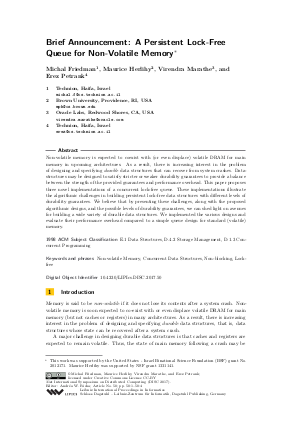Brief Announcement: A Persistent Lock-Free Queue for Non-Volatile Memory
Authors Michal Friedman, Maurice Herlihy, Virendra Marathe, Erez Petrank
-
Part of:
Volume:
31st International Symposium on Distributed Computing (DISC 2017)
Part of: Series: Leibniz International Proceedings in Informatics (LIPIcs)
Part of: Conference: International Symposium on Distributed Computing (DISC) - License:
 Creative Commons Attribution 3.0 Unported license
Creative Commons Attribution 3.0 Unported license
- Publication Date: 2017-10-12
File

PDF
LIPIcs.DISC.2017.50.pdf
- Filesize: 360 kB
- 4 pages
Document Identifiers
Subject Classification
Keywords
- Non-volatile Memory
- Concurrent Data Structures
- Non-blocking
- Lock-free
Metrics
- Access Statistics
-
Total Accesses (updated on a weekly basis)
0PDF Downloads0Metadata Views
Abstract
Non-volatile memory is expected to coexist with (or even displace) volatile DRAM for main memory in upcoming architectures. As a result, there is increasing interest in the problem of designing and specifying durable data structures that can recover from system crashes. Data-structures may be designed to satisfy stricter or weaker durability guarantees to provide a balance between the strength of the provided guarantees and performance overhead. This paper proposes three novel implementations of a concurrent lock-free queue. These implementations illustrate the algorithmic challenges in building persistent lock-free data structures with different levels of durability guarantees. We believe that by presenting these challenges, along with the proposed algorithmic designs, and the possible levels of durability guarantees, we can shed light on avenues for building a wide variety of durable data structures. We implemented the various designs and evaluate their performance overhead compared to a simple queue design for standard (volatile) memory.
Cite As Get BibTex
Michal Friedman, Maurice Herlihy, Virendra Marathe, and Erez Petrank. Brief Announcement: A Persistent Lock-Free Queue for Non-Volatile Memory. In 31st International Symposium on Distributed Computing (DISC 2017). Leibniz International Proceedings in Informatics (LIPIcs), Volume 91, pp. 50:1-50:4, Schloss Dagstuhl – Leibniz-Zentrum für Informatik (2017)
https://doi.org/10.4230/LIPIcs.DISC.2017.50
BibTex
@InProceedings{friedman_et_al:LIPIcs.DISC.2017.50,
author = {Friedman, Michal and Herlihy, Maurice and Marathe, Virendra and Petrank, Erez},
title = {{Brief Announcement: A Persistent Lock-Free Queue for Non-Volatile Memory}},
booktitle = {31st International Symposium on Distributed Computing (DISC 2017)},
pages = {50:1--50:4},
series = {Leibniz International Proceedings in Informatics (LIPIcs)},
ISBN = {978-3-95977-053-8},
ISSN = {1868-8969},
year = {2017},
volume = {91},
editor = {Richa, Andr\'{e}a},
publisher = {Schloss Dagstuhl -- Leibniz-Zentrum f{\"u}r Informatik},
address = {Dagstuhl, Germany},
URL = {https://drops.dagstuhl.de/entities/document/10.4230/LIPIcs.DISC.2017.50},
URN = {urn:nbn:de:0030-drops-79689},
doi = {10.4230/LIPIcs.DISC.2017.50},
annote = {Keywords: Non-volatile Memory, Concurrent Data Structures, Non-blocking, Lock-free}
}
Author Details
References
-
Joseph Izraelevitz, Hammurabi Mendes, and Michael L. Scott. Linearizability of persistent memory objects under a full-system-crash failure model. In Distributed Computing - 30th International Symposium, DISC, pages 313-327, 2016.

-
Maged M. Michael and Michael L. Scott. Simple, fast, and practical non-blocking and blocking concurrent queue algorithms. In Proceedings of the Fifteenth Annual ACM Symposium on Principles of Distributed Computing (PODC), pages 267-275, 1996.

